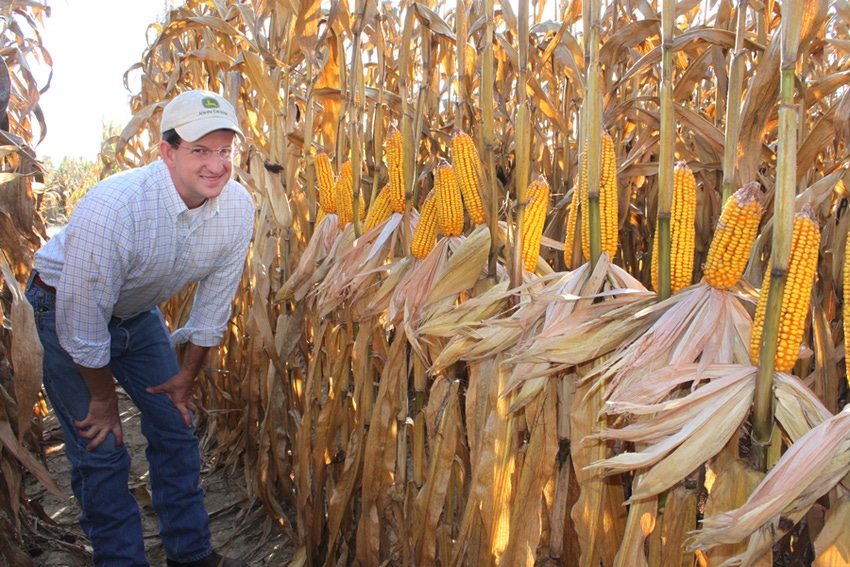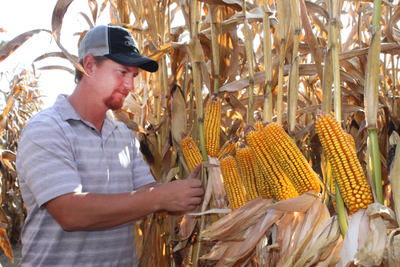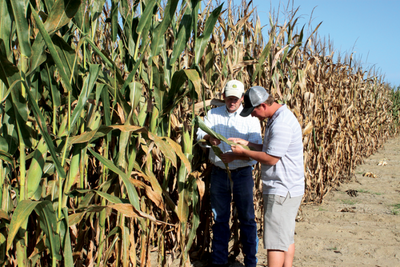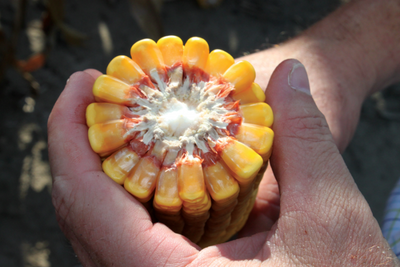
Dryland high density corn yields were even higher than expected, says Brien Henry of his trials at Mississippi State Univeristy and at the North Mississippi Research and Extension Center at Verona. “At both locations, the higher plant populations had higher yields than those in the lower ‘normal’ range."

They were Brien Henry’s corn plots deliberately designed not to do well — dryland, high population plantings that are a part of his trials each year to demonstrate to growers that yields usually suffer with high plant numbers in a dryland system.
“They’re the examples we use to tell farmers, ‘This is what you shouldn’t do,’” says Henry, associate professor of plant and soil sciences at Mississippi State University. “We include them in our trials, knowing they won’t do as well as plantings in the long-term optimum range.”
But, surprise! In this year’s growing season of frequent rains and a record cool July, it was his thou-shalt-not plots that harvested the highest yields — as was also the case in 2013, which had an atypically wet, cool summer.
And, he believes, by planting higher populations earlier to take advantage of cooler, wetter conditions — comparable to those during the 2013-2014 growing seasons — producers could avoid the typically blazing hot summer weather that can hamper corn growth during critical stages, and realize a significant boost in yield.

MATTHEW HOCK, Mississippi State University graduate student, assisted with dryland corn plot research.
On a pre-harvest tour of the plots August 22, when corn was ready to harvest and was at 16 percent moisture, Henry and Matthew Hock, a graduate student working on his master’s in agronomy, could hardly restrain their enthusiasm and were itching to see the post-harvest yield data.
“Our high plant population trials yielded exceptionally well in 2013, and this year looks even better,” Henry said that day. “It’s just amazing how good the high population corn looks.
“The ears may not be quite as large in the high density plantings, but there are more of them — they almost touch each other from stalk to stalk. I believe the high population plots are going to blow the others out of the water again this year.”
And he was right.
“The yields were even higher than we expected,” he said of his trials at MSU and at the North Mississippi Research and Extension Center at Verona. “At both locations, the higher plant populations had higher yields than those in the lower ‘normal’ range.
Stay current on what’s happening in Mid-South agriculture: Subscribe to Delta Farm Press Daily.
“Yields in replicated trials at Verona were from 173 bushels to 248 bushels. At the university farm, our replicated plots ranged from 250 bushels to 275 bushels, with a few individual plots eclipsing 300 bushels — really fantastic yields for dryland corn.”
That compared to a 200-220 bushel yield range for the “normal” plant populations.
In 2013, in trials at the MSU Black Belt Experiment Station at Brooksville, Miss., station, the higher population plots yielded 180 to 200 bushels, and at the Verona station yields ranged from 220 to 230 bushels.
Varieties in the trials this year included Dekalb, Pioneer, and Agrisure.
Advantages of early planting
“With Mississippi’s typical summer heat, and sometimes drought, about the only way to avoid those weather extremes with corn is to plant earlier,” Henry says. “But that often involves issues with frost, saturated soils, etc.

CHECKING CORN PLOTS for diseases are Brien Henry and Matthew Hock.
“This year and last year have been abnormal from a summer weather standpoint. We had no really high temperatures during the growing season — that was particularly true for critical nighttime temperatures — and we had timely rains. All in all, we had near-ideal conditions for corn development, and boy, did the corn respond positively!
“These results demonstrate that if we could say for certain that we’d have those growing conditions, we could with confidence tell growers to use higher plant populations.
“But because we can’t know what the weather is going to do, we can’t look a grower in the eye and say, ‘This is what you should do every year.’ What we can say, however, is that probably in four years of five, the odds of success with early planting/higher populations will be in your favor — and the higher yields in those years should compensate for the years with not-so-high yields.”
Henry’s trials included multiple hybrids, multiple planting dates, and plant populations ranging from 20,000 per acre on the low end to 40,000 on the high side, all dryland.
Varieties respond differently to high density
“Most of our Mississippi dryland farmers will have plant populations in the 25,000 to 28,000 range,” he says. “But for our data comparison purposes, we include plots at the low end and the high end, knowing that in a ‘normal’ season with ‘normal’ planting dates, they can be expected not to perform as well as those in the optimum population range.”

RESEARCH DATA for the corn yield plots included such information as rows of kernels, kernel weight, and other factors that influence yield.
And he says, some varieties respond better in high population plantings than others. He collects a wide range of data, including kernel weight, number of rows of kernels per ear, etc. — all the factors that have an influence on yield, with the hopes of giving growers a way to harvest even more bushels per acre.
Ideally, Henry says, corn breeders will develop varieties that are more cold/frost tolerant, allowing Mid-South growers to plant earlier, with higher plant populations, so the crop can move through critical development stages before the worst of summer’s heat/drought come along.
“Corn plants are pretty resilient,” he says. “We’ve done work where we manually cut the tops out of young plants, or chop them out with a WeedEater, to simulate frost/freeze damage, and they have a remarkable ability to recover. I don’t think it’s outside the realm of possibility that we’ll see breeders develop varieties that are more frost/freeze tolerant.
“This would certainly be a benefit to growers in the South. By planting earlier and boosting plant populations, we should be able to obtain a significant boost in corn yields.”
Henry, a Starkville native who spent four years as a USDA-ARS research agronomist in Colorado and six years as a plant breeder with the USDA’s aflatoxin group before coming to Mississippi State University, expresses gratitude to the state’s corn growers and the Mississippi Corn Promotion Board for their support of this research. “We appreciate very much their assistance in making our research possible,” he says.
Performance data from the 2014 MSU variety trials are available at http://bit.ly/1slK9Ll and specific 2014 yield data on planting dates and populations will be available very soon, Henry says.
About the Author(s)
You May Also Like



